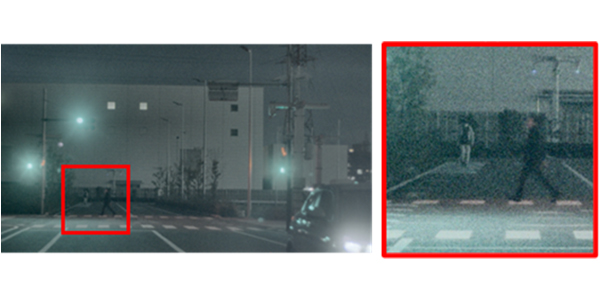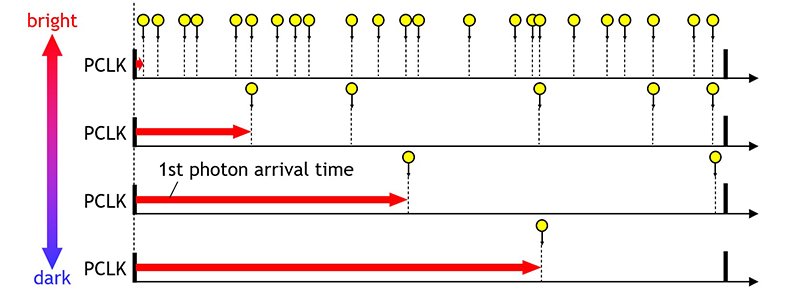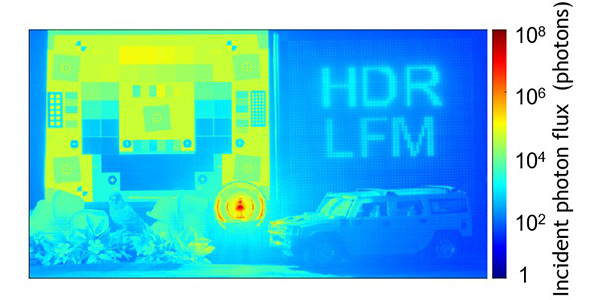News Release
June 12, 2025
Canon Inc.
Canon develops High Dynamic Range SPAD sensor with potential to detect subjects even in low-light conditions or environments with strong lighting contrasts thanks to unique technology
TOKYO, June 12, 2025—Canon Inc. announced today that it has developed a 2/3" SPAD sensor featuring approximately 2.1 megapixels and a high dynamic range of 156dB. Thanks to a unique circuit technology, it realizes high dynamic range, low power consumption, and the ability to mitigate flickering from LED lights. Canon will continue further technological development and aims to start mass production.

(Prototype)

(Footage taken with 25 mm focal length and f/1.4 aperture)
SPAD sensors employ a principle called photon counting, which detects each photon (light particle) entering a pixel and counts the incident number of photons. This sensor does not take in any noise during the readout process, making it possible to capture a clear image of subjects. Also, it can measure the distance to the subject at high speed with excellent timing precision.
However, due to limitations in processing speed, when the incident number of photons exceed a certain threshold level under high-illuminance conditions, conventional SPAD sensors experienced difficulties when separating individual photons to read out, which led the acquired image to white-out. In addition, such sensors consume a large amount of power as each photon counting independently consumes power.
On the other hand, Canon's newly developed SPAD sensor uses a unique technology called “weighted photon counting.” Focusing on the fact that the frequency at which photons reach the sensor correlates with illuminance, this technology measures the time it takes for the initial photon to reach the pixel within a certain time frame, then estimates the total number of photons that will arrive at the pixel over a certain time period. As a result, the image does not white-out due to a large number of photons precisely estimated while they are not being actually counted, allowing the subject to be captured clearly.
While the conventional SPAD sensor actually counts all incident photons one by one, the new method estimates the total amount of incident photons within a certain timeframe based on the time it takes for the first incident photon to arrive. As a result, the new sensor achieves a high dynamic range of 156dB, approximately five times higher than the previous sensor2. At the same time, this approach limits the power consumption per pixel by roughly 75% by reducing the frequency of photon detections. In addition, this technology also mitigates the flickering that occurs when capturing light from LEDs such as traffic lights.
Canon anticipates that this new sensor will have a wide variety of applications, such as surveillance, onboard vehicle equipment, and industrial use. For instance, it is expected to be applied to autonomous driving3 and advanced driving-assistance systems3. As autonomous driving technology advances, the demand for onboard sensors is increasing. At the same time, as many countries increasingly tighten related safety standards, there is a need for advanced sensor technology to ensure the safety of autonomous driving. However, the currently available CMOS sensors that are commonly used in vehicles are known to have several issues with visibility in environments with strong contrasts between bright and dark scenes, such as tunnel exits, or extremely low light conditions. Canon has addressed these issues by combining new features with the conventional SPAD sensors, which excel in low-light shooting.
Canon announced this new sensor technology on June 12, 2025 at the 2025 Symposium on VLSI Technology and Circuits held in Kyoto, Japan.
Canon will continue to create new value harnessing the power of technology and innovation to contribute to solving social issues.
- 1
For reference, a full moon night measures about 0.2 lux.
- 2
In contrast to automated driving (AD), in which the system is the main driver and achieves fully automatic driving,
- 3
In contrast to automated driving (AD), in which the system is the main driver and achieves fully automatic driving, advanced driver-assistance systems (ADAS) enable safer driving by supporting human-operated driving.
Overview of the new SPAD sensor
- While conventional SPAD sensors count all incident photons one by one, the newly developed SPAD sensor uses a unique technology called weighted photon counting that estimates the total amount of incident photons within a certain period of time based on the detection of the first incident photon. This greatly widens the number of photons that can be measured.
- This technology can also mitigate flickering when light from LEDs such as traffic lights is captured.

The earlier the arrival of the first incident photon, the brighter the incident light.


- General Enquiries
Please include the keyword "SPAD sensor development" in the email subject line.
